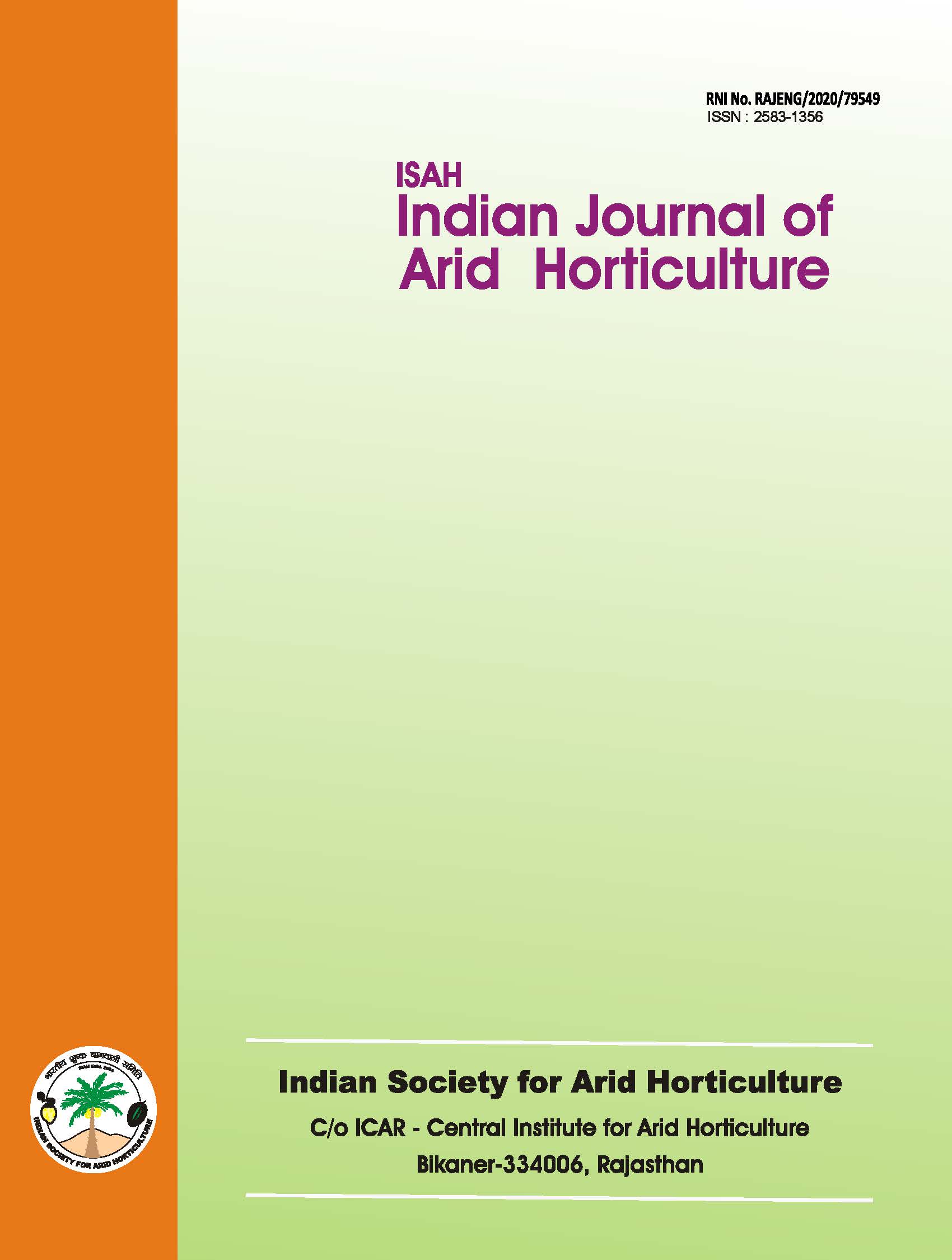Physiological and biochemical changes in ber (Zizyphus mauritiana Lamk.) due to Pestalotiopsis fruit rot
Keywords:
Pestalotiopsis, phenols, ascorbic, soluble solidsAbstract
In the present experiment, different physiological and biochemical parameters of ber infected with Pestalotiopsis fruit rot were studied. The sites of inoculation of ber fruits were tested and the inoculation at epicarp surface was found most sensitive and showing maximum severity of Pestalotiopsis rot. The mature and ripe stage inoculated fruits exhibited maximum severity. Changes in biochemical activity indicated that the level of total soluble solids, acidity, ascorbic acid and phenols in healthy ripe and semi-ripe ber fruits were higher as compared to infected ripe and semi-ripe fruits. The total soluble solids in inoculated semi- ripe fruits was significantly lower than uninoculated semi-ripe fruits and inoculated ripe fruits, it was lower than uninoculated ripe fruits. The level of acidity in the inoculated ripe and semi-ripe ber fruits was significantly reduced than uninoculated ripe and semi- ripe fruits. The level of ascorbic acid in inoculated ripe and semi-ripe fruits was significantly low over control. The healthy fruits (semi-ripe stage) of ber had much larger amount of ascorbic acid as compared to the diseased fruits. The activity of total phenols was higher in healthy and diseased semi-ripe fruits (0.62 and 0.48 mg/100 gm fruits) as compared to healthy ripe and diseased ripe fruits (0.52 and 0.19 mg/100 gm fruits), respectively.Downloads
References
A.O.A.C. 1990. Official and tentative method of analysis.
Assoc. Agric. Chem. 18th ed., Washington, D.C. Barkai-Golan, R. 2005. Post harvest diseases of fruits and vegetables: Development and control. Elsevier Science B:V., Amsterdam.
Bray, H.G. and Thorpe, W.V. 1954. Analysis of phenolic compounds of metabolism interest. Meth. Biochem. Anal., 1:27-52.
Dubois, M., Gilles, K., Hamilton, J.K., Rebers, P.A. and
Smith, F. 1951. A colorimetric method for the determination of sugars. Nature, 168: 167. Farkas, G.L. and Kiraly, Z. 1962. Role of phenolic compounds in the physiology of plant diseases and disease resistance. Phytopath. Z., 44: 105-150.
Fourie, J.F. and Holz, G. 1998. Initial infection processes by Botrytis cinerea and infection of plum and nectarine fruit. Plant Dis., 82: 165-170.
Goel, A. and Siddiqui, S. 1999. Changes in enzyme activities and physico-chemical characteristics of ber. Indian J. Agric. Res., 33 (3): 209-213.
Hudson, B.J.F. and Mahgoub, S.E.O. 1980. Naturally occurring antioxidants in leaf lipids. J. Sci. Food Agric., 31:646:650.
Jat, R.G., Agarwal, V.K. and Goyal, S.K. 1997. Studies on post harvest fungal disease of ber fruits. Proceedings of
Golden Jubilee International Conference on Integrated Plant Disease Management for Sustainable Agriculture, Indian Phytopathological Society, 11-15 Nov, IARI, New Delhi. 313 pp. Meena, O.P. 2006. Studies on post harvest fruit rot of guava caused by Pestalotiopsis palmarum. M.Sc. (Ag.) Thesis, Rajasthan Agricultural University, Bikaner. Nallathambi, P., Umamaheswari, C., Vashistha, B.B. and Nath, Vishal. 2000. Fruit rot (Alternaria alternata) and sources of resistance in ber germplasm under arid conditions. Ann. Arid Zone, 39(4): 477-478. Nicholson, R.L., Hipskind, J. and Hanau, R.M. 1989. Protection against phenol toxicity by the spore mucilage of Colletotrichum graminicola, an aid of secondary spread. Physiol. Mol. Plant Pathol., 35: 243-252.
Rai, R.N. 1982. Pathological and physiological studies of certain fungi causing fruit rot diseases. D.Phil Thesis, Allahabad Univ., Allahabad, India, 217. Somogyi, M. 1952. Aresenomolybdate reagent colour development method of reducing sugar determination. J. Biol. Chem., 200 245. Takahama, U. 1985. Inhibition of lipoxygenase- dependent peroxidation by quercitin: Mechanism of antioxidative function. Photochemistry, 24: 1443- 1446.

